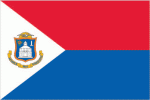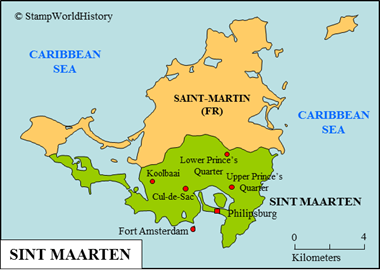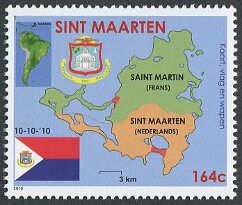
Sint Maarten
Quick reference
General issues: Self governing country within the Kingdom of the Netherlands 2010-Present
Country name on general issues: Sint Maarten
Currency: 1 Gulden = 100 Cents 2010-Present
Population: 37 000 in 2014
Political history Sint Maarten
Sint Maarten – also called Saint Martin in English – is located in the Caribbean as one of the Leeward Islands, the northern part of the Lesser Antilles. For the exact location, please refer to the map of the Caribbean. Sint Maarten was, prior to colonization, inhabited by the Amerindian Carib, a people found on many of the Lesser Antilles. The first European to sight Sint Maarten was Christopher Columbus in 1493. The Spanish claimed, but did not settle, the island. Both the Dutch and the French settled on the island in the first part of the 17th century. In 1648, Spain relinquished its claims and the Dutch and the French signed an agreement on the division of Sint Maarten. Nonetheless, the island would be disputed – and, at times, occupied – by the British, the Dutch and the French throughout the 17th and 18th centuries. Dutch and French sovereignty were, finally, acknowledged in 1815 and Sint Maarten was divided along the lines of the 1648 agreement.
Initially, Sint Maarten was administered by the Dutch West India Company, a chartered company, but the island was transferred to the Dutch Crown in 1791. From 1848, Sint Maarten was administered as part of the colony of Curacao & Dependencies, together with the other Dutch possessions in the Caribbean. Curacao & Dependencies was renamed the Netherlands Antilles in 1948. The Netherlands Antilles became a constituent country in the kingdom of the Netherlands in 1954 and, as such, self governing. In 2010, the Netherlands Antilles were dissolved, and Sint Maarten became a self governing country within the kingdom of the Netherlands itself – which it is until today.
Economically, Sint Maarten was, initially, of importance because of its salt deposits. In the 18th and 19th centuries plantations were developed – cotton, tobacco and sugar cane being the most important crops. To man the plantations, slaves were brought to the island – slaves that would soon outnumber the population of European descent. In the 20th century, tourism has developed to become the mainstay of the economy. The population is diverse, with 50% of the population having Dutch nationality and the other 50% being of different nationalities.
Postal history Sint Maarten
The first post office was opened on Sint Maarten in the 1880’s. Initially, the stamps of Curacao & Dependencies were used. These were superseded by the issues of the Netherlands Antilles in 1948. Sint Maarten, as a self governing country, issued its first stamps in 2010 – the first issue commemorating the achievement of self government. Sint Maarten has, since then, issued a blend of stamps with themes of national interest and themes aimed at the thematic collectors market.
Album pages
← Previous page: Saint-Pierre & MiquelonNext page: Spanish West Indies →



